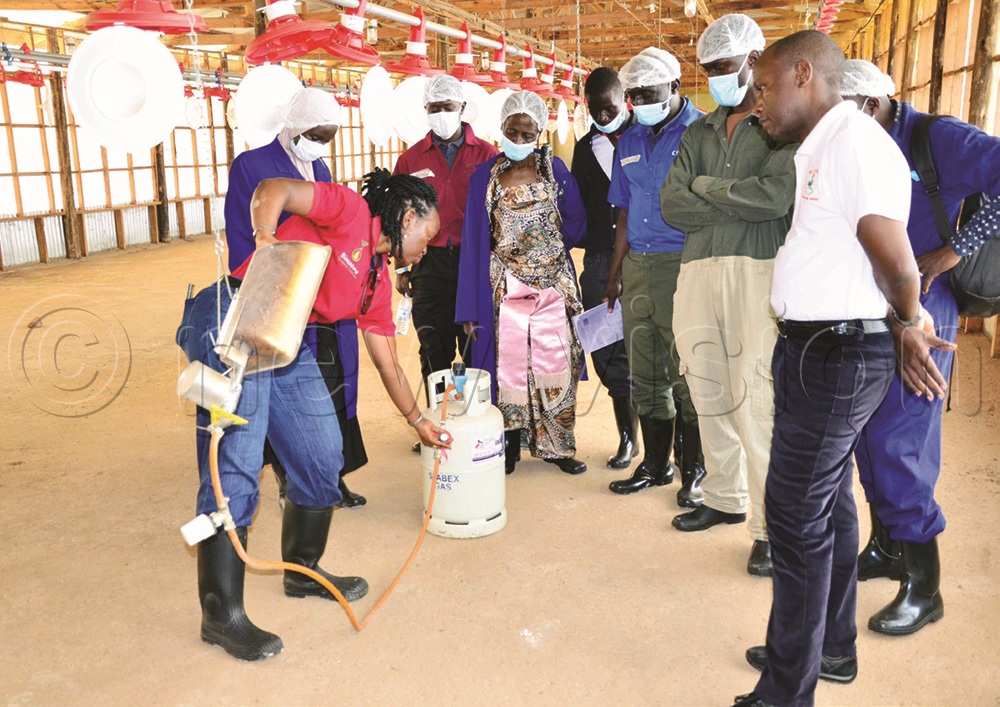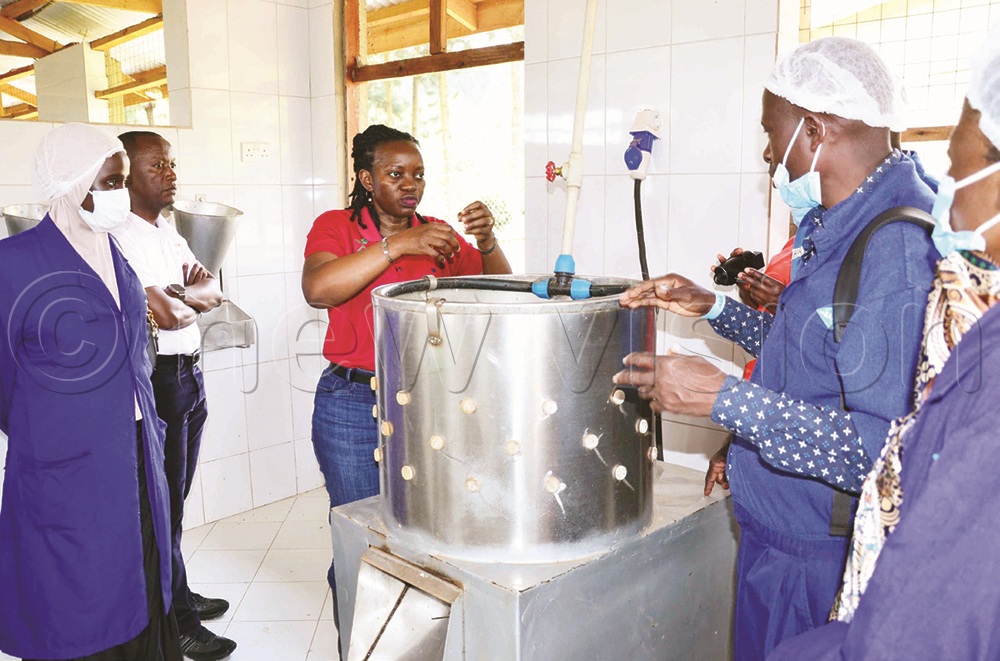Biogas brooder saves energy, cuts costs
“Unlike charcoal stoves, biogas systems offer accurate temperature control, reducing risks for both attendants and birds,” Gabindadde said.
Sserwanga explaining how modem feeders and drinkers are operated at Biwooma Farm in Gayaza. (Photos by Herbert Musoke)
________________
Uganda’s poultry industry is soaring — millions of chickens, thousands of households, and a growing appetite for agribusiness.
According to the National Livestock Census 2021, the country’s chicken population reached 57.8 million, with seven in 10 livestock-keeping households raising poultry.
This marks a significant rise from 3.2 million households in 2008 to 4.8 million in 2021 — a 49.9% increase. Indigenous breeds dominate at 69.9%, but exotic breeds are steadily gaining ground.
In 2020 alone, Uganda produced 69,991 tonnes of poultry meat and 44,667 tonnes of eggs, reflecting the sector’s growing economic importance.
The central region leads with 35.7% of the national poultry population, and Wakiso district tops the list with 5.6 million birds.
Yet, despite this growth, many farmers struggle to unlock the full potential of poultry farming due to knowledge gaps.
To address this, Bukedde has launched initiatives to promote agribusiness best practices and empower farmers to transition from subsistence to commercial agriculture.

Gabindadde showing how biogas is used in the brooder house.
“In Bukedde, we have a product where experts train farmers to treat agriculture as a business to improve their profitability,” Michael Mukasa Ssebbowa, the editor of Bukedde newspaper, recently said.
Training at Biwooma farm
To put this vision into action, Bukedde organised a poultry training session at Biwooma Farm in Gayaza, Wakiso district.
Farmers learnt how biogas-powered brooders can revolutionise chick rearing by cutting costs, improving safety and turning farm waste into fuel.
“As charcoal prices soar, this energy-saving technology is set to transform Uganda’s poultry sector,” Justine Namukwaya, a farmer from Mpererwe, Kampala, said.
The training was facilitated by Robert Sserwanga, executive director of Agrarian Systems and a regular trainer at the Harvest Money Expo.
Topics included biosecurity, poultry house construction, breed selection, brooding, feeding, and marketing.
Key lessons from the training
Biosecurity matters
The session began with a strong emphasis on biosecurity. Participants were sanitised and provided with overalls and boots to prevent disease transmission.
“Place footbaths with disinfectants like bleach or lime at every poultry house entrance,” Sserwanga advised.
“Everyone, that is, owners, workers, vets and visitors, must use them.”
Biogas brooding technology
Biogas brooding emerged as a game-changer. Gorret Gabindadde Biwooma, CEO of Biwooma, explained how farm waste is converted into fuel to warm brooding areas.
Heat is distributed via brooder boxes or hot water pipes, with temperature gauges ensuring precision.

Gabindadde (centre) explains how a chicken slaughter business can be run successfully. This was at Biwooma Farm in Gayaza, Wakiso
“Unlike charcoal stoves, biogas systems offer accurate temperature control, reducing risks for both attendants and birds,” Gabindadde said.
Initially developed to manage chicken droppings, the biogas system now powers brooding and cooking on the farm. Although installation is costly, Gabindadde notes that it becomes economical over time.
“We spend about sh1.2m to brood 500 layer chicks for two weeks, compared to sh2.5m using charcoal,” she said.
Gabindadde recommends biogas for farms with over 10,000 birds, and stresses the importance of expert installation and safety training.
Constructing a poultry house
Proper poultry house design is critical. Sserwanga advised building with the width facing east-west and the length north-south to minimise direct sunlight.
“Sunlight can cause crowding, suffocation, reduced feeding, and poor growth,” he warned.
This spoke to some of the participants like Noordin Kulumba, a farmer from Mbale.
He said he realised his chickens’ poor performance was due to direct sunlight affecting feeding behaviour. Modern houses should have easy-to-clean floors and observation windows.
Choosing the right breed
Breed selection should be based on traits and market demand — not brand names.
“For drumsticks, choose Cobb500. For chest meat, go with Cobb500MX,” Sserwanga said.
For layers, consider egg size, quantity, shape, colour and laying duration. Husein Kamugisha from Kiboga expressed gratitude for the insights.
“I didn’t know chickens had such breed differences. This information is vital, it determines your farm’s output.”
Understanding the market
Sserwanga emphasised market research before starting poultry farming.
“Don’t wait until harvest to think about selling. Know your market’s needs — it guides your breed choice, feeding plan, and stocking schedule.”
Other business opportunities
Gabindadde highlighted income opportunities along the poultry value chain, such as setting up slaughterhouses or brooding chicks for sale.
“You can charge sh500–sh1,500 to slaughter a chicken. Broilers sell at sh6,500 at 14 days, while layers fetch sh18,000–20,000 at two to three months,” she said.
Monica Acayo from Namayumba, Wakiso district, asked about the cost of de-feathering machines.
Gabindadde responded that imported machines cost over sh150m.
“We found a local fabricator in Matugga, Wakiso district, who built ours for sh3m and handles repairs,” she said.
Biwooma Farm also connects farmers with experts in biogas and machinery to support their agribusiness journey.
Bukedde’s commitment to farmer empowerment
Bukedde newspaper editor Michael Mukasa Ssebbowa thanked those who attended a poultry training session at Biwooma Farm in Gayaza, Wakiso district recently and reaffirmed the publication’s dedication to community transformation.
“As Uganda’s leading media house, we aim to uplift communities economically and socially. These trainings extend our Harvest Money Expo initiative.”
Bukedde’s farming pages offer expert guidance from idea to market.
“We’ve just completed a poultry series and are now starting on coffee farming, followed by hands-on training sessions,” he added.